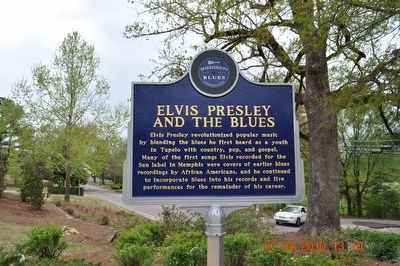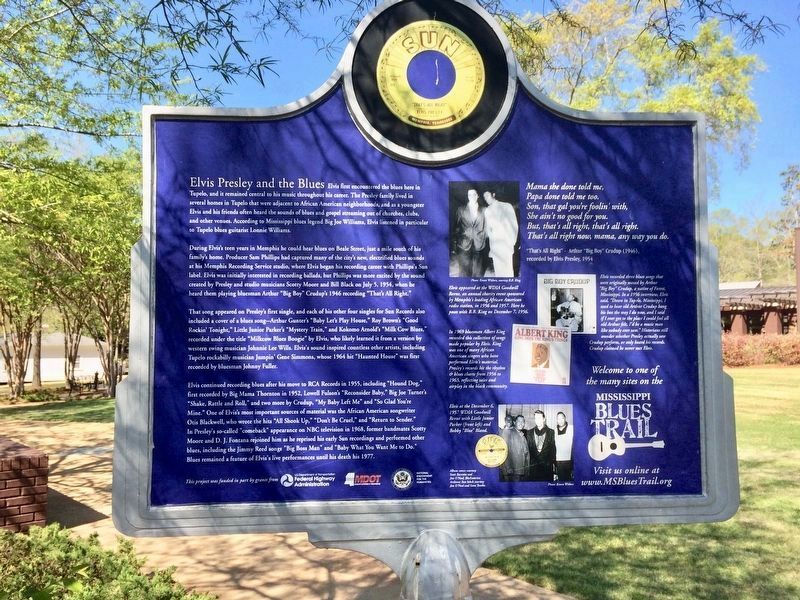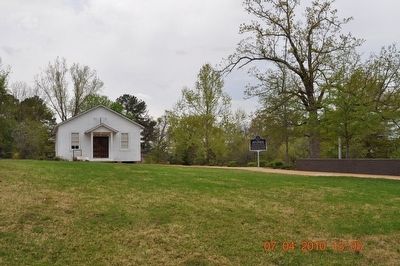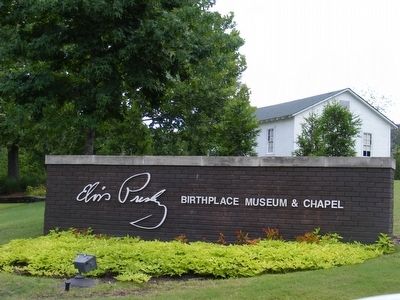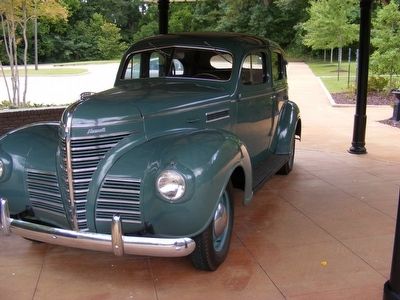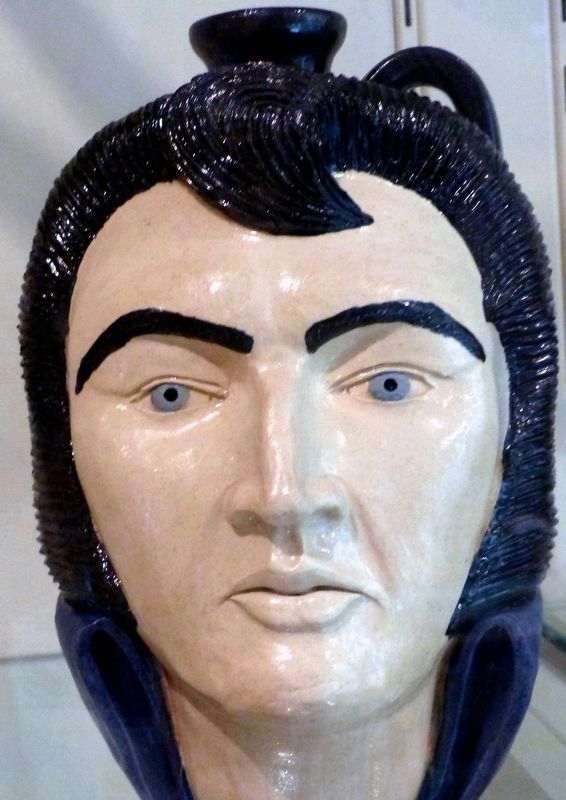Tupelo in Lee County, Mississippi — The American South (East South Central)
Elvis Presley and the Blues
Elvis Presley revolutionized popular music by blending the blues he first heard as a youth in Tupelo with country, pop, and gospel. Many of the first songs Elvis recorded for the Sun label in Memphis were covers of earlier blues recordings by African Americans, and he continued to incorporate blues into his records and live performances for the remainder of his career.
Marker Rear:
Elvis first encountered the blues here in Tupelo, and it remained central to his music throughout his career. The Presley family lived in several homes in Tupelo that were adjacent to African American neighborhoods, and as a youngster Elvis and his friends often heard the sounds of blues and gospel streaming out of churches, clubs, and other venues. According to Mississippi blues legend Big Joe Williams, Elvis listened in particular to Tupelo blues guitarist Lonnie Williams. During Elvisís teen years in Memphis he could hear blues on Beale Street, just a mile south of his familyís home. Producer Sam Phillips had captured many of the cityís new, electrified blues sounds at his Memphis Recording Service studio, where Elvis began his recording career with Phillips's Sun label. Elvis was initially interested in recording ballads, but Phillips was more excited by the sound created by Presley and studio musicians Scotty Moore and Bill Black on July 5, 1954, when he heard them playing bluesman Arthur “Big Boy” Crudupís 1946 recording “Thatís All Right.” That song appeared on Presleyís first single, and each of his other four singles for Sun Records also included a cover of a blues song—Arthur Gunterís “Baby Letís Play House,” Roy Brownís “Good Rockiní Tonight,” Little Junior Parkerís “Mystery Train,” and Kokomo Arnoldís “Milk Cow Blues,” recorded under the title “Milkcow Blues Boogie” by Elvis, who likely learned it from a version by western swing musician Johnnie Lee Wills. Elvis's sound inspired countless other artists, including Tupelo rockabilly musician Jumpin' Gene Simmons, whose 1964 hit “Haunted House” was first recorded by bluesman Johnny Fuller. Elvis continued recording blues after his move to RCA Records in 1955, including “Hound Dog,” first recorded by Big Mama Thornton in 1952, Lowell Fulsonís “Reconsider Baby,” Big Joe Turnerís “Shake, Rattle and Roll,” and two more by Crudup, “My Baby Left Me” and “So Glad Youíre Mine.” One of Elvisís most important sources of material was the African American songwriter Otis Blackwell, who wrote the hits “All Shook Up,” “Donít Be Cruel,” and “Return to Sender.” In Presley's so-called "comeback" appearance on NBC television in 1968, former bandmates Scotty Moore and D. J. Fontana rejoined him as he reprised his early Sun recordings and performed other blues, including the Jimmy Reed songs "Big Boss Man" and "Baby What You Want Me to Do." Blues remained a feature of Elvis's live performances until his death his 1977.
Erected 2008 by the Mississippi Blues Commission. (Marker Number 28.)
Topics and series. This historical marker is listed in these topic lists: African Americans • Arts, Letters, Music • Entertainment. In addition, it is included in the Mississippi Blues Trail series list. A significant historical month for this entry is July 2008.
Location. 34° 15.572′ N, 88° 40.792′ W. Marker is in Tupelo, Mississippi, in Lee County. Marker can be reached from Elvis Presley Drive near Berry Street. Marker is located on grounds of Elvis Presley's birth home, museum and Church. Touch for map. Marker is at or near this postal address: 306 Elvis Presley Drive, Tupelo MS 38804, United States of America. Touch for directions.
Other nearby markers. At least 8 other markers are within walking distance of this marker. Elvis Presley's Childhood Church (here, next to this marker); Elvis Country (within shouting distance of this marker); The Outhouse (within shouting distance of this marker); The Birthplace / East Tupelo 1935-1948 (within shouting distance of this marker); Birthplace of Elvis Presley (within shouting distance of this marker); Native American Site (approx. 0.2 miles away); Town Creek Tupelo Encampment / Camp Life in Tupelo (approx. ľ mile away); The Tupelo Swamp / Plank Road (approx. one mile away). Touch for a list and map of all markers in Tupelo.
Also see . . . Elvis and the Blues - Tupelo. (Submitted on December 25, 2012.)
Credits. This page was last revised on August 30, 2017. It was originally submitted on April 9, 2010, by Sandra Hughes Tidwell of Killen, Alabama, USA. This page has been viewed 1,869 times since then and 70 times this year. Last updated on April 15, 2010, by Paul Jordan of Burlington, N. C., U. S. A.. Photos: 1. submitted on April 9, 2010, by Sandra Hughes Tidwell of Killen, Alabama, USA. 2. submitted on April 9, 2017, by Mark Hilton of Montgomery, Alabama. 3. submitted on April 9, 2010, by Sandra Hughes Tidwell of Killen, Alabama, USA. 4, 5. submitted on December 13, 2012, by Don Morfe of Baltimore, Maryland. 6. submitted on April 11, 2017, by Allen C. Browne of Silver Spring, Maryland. • Kevin W. was the editor who published this page.
